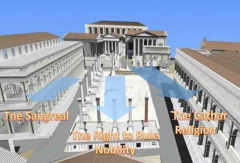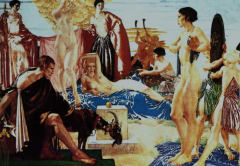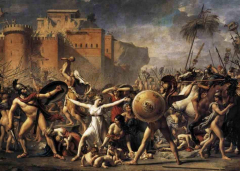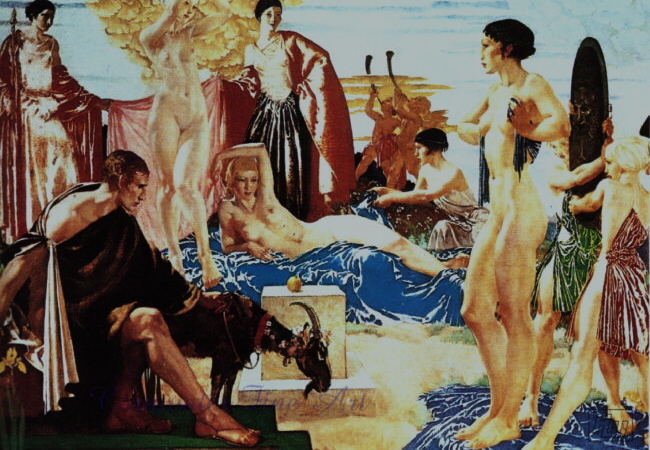Fact? or Interpretation?
 In following through the factors which influenced Ximene’s thinking and the way she lived her life, consideration of Concepts of Nobility, the origins of the Cathar and Christian Churches, the question of wether Occitan was ever an independent state and the phenomenon of the Sangreal were all investigated. All lead back to the time when the western world was dominated by the Roman Empire. What the Roman Empire actually was is a rather different matter. Remember that there are opinions ( See History of History) that everything we know about classical civilisations was invented by monks in scriptoria in the middle ages, to suit the political and theological initiatives they wished to propagate.
In following through the factors which influenced Ximene’s thinking and the way she lived her life, consideration of Concepts of Nobility, the origins of the Cathar and Christian Churches, the question of wether Occitan was ever an independent state and the phenomenon of the Sangreal were all investigated. All lead back to the time when the western world was dominated by the Roman Empire. What the Roman Empire actually was is a rather different matter. Remember that there are opinions ( See History of History) that everything we know about classical civilisations was invented by monks in scriptoria in the middle ages, to suit the political and theological initiatives they wished to propagate.
From a multitude of ancient ruins, we know about the Roman technology and their ability to build,. We know the names of the rulers from coins and fragmentary historical records. However we know little with certainty, about the politics and structure or even the timeline of of the empire.
Too much of our knowledge is based on the fragmentary reprints of a limited number of classical documents all of which are copies produced in the notorious scriptoria giving limitless opportunities for “modifying” history to conform with the politically and theological correctness of the early middle ages.
Even in mainstream history vastly different interpretations are not only possible but necessary to reconcile apparently contradictory information.
The Aeneid
 According to the Aeneid the Roman story commences with the judgement of Paris. Paris was the son of Trojan king Priam and is asked by Zeus to decide who is the most beautiful of the three goddesses; Hera(Roman Juno), Athena (Roman Minerva) and Aphrodyte (Roman Venus) .
According to the Aeneid the Roman story commences with the judgement of Paris. Paris was the son of Trojan king Priam and is asked by Zeus to decide who is the most beautiful of the three goddesses; Hera(Roman Juno), Athena (Roman Minerva) and Aphrodyte (Roman Venus) .
To ask a mortal to make a judgement on the relative beauty of three goddesses was undoubtably a poisoned chalice. Paris chose Aphrodyte, mother of his cousin Aeneas, as the most beautiful and thereby brought the hatred of the Goddess Hera down on the Trojans.
Aeneus was the son of Prince Anchises and the Goddess Aphrodyte. Anchises was the second cousin of King Priam of Troy and as a Trojan hero he is mentioned in Homer’s Iliad.
Aphrodyte, as a measure of her appreciation of Paris’ judgement gave him the affection of most beautify woman in the world. His woman was Helen of Sparta, wife of Meneleus. Paris then abducted Helen and took her to Troy. Hera used this as an opportunity to encourage and assist the Greeks to attack and destroy Troy.
As well as featuring in the Iliad Aeneus appears in the Aeneid by Virgil, Ab Urbe Condita by Livy, Roman Antiquities by Dionysus and Origines by Rato , According to the Roman versions, Aeneus escaped the sack of troy and after numerous adventures landed in Italy. Rome claimed that Aeneus was the ancestor of Romulus and Remus, the founders of Rome. It also meant that leading roman patrician families were descended from “the gods”
The Sabine Women
 Rome’s expansion began, according to its own foundation traditions (more myths?) within the lifetime of it’s founder Romulus. The justification for the expansion was that the founders needed wives.
Rome’s expansion began, according to its own foundation traditions (more myths?) within the lifetime of it’s founder Romulus. The justification for the expansion was that the founders needed wives.
They seized by force women belonging to the neighbouring Sabine tribe but during the subsequent war the women interceded and achieved a peace settlement. The names of the original thirty patrician families was based on the names of thirty of the Sabine women.
Whether this version of events is fact or an early example of pseudo history is less important than the fact that it was enshrined in the Roman mentality. This founding myth, building on and adding to the earlier stories of Helen’s abduction to Troy legitimised the conquest of other peoples and the abduction of women.
